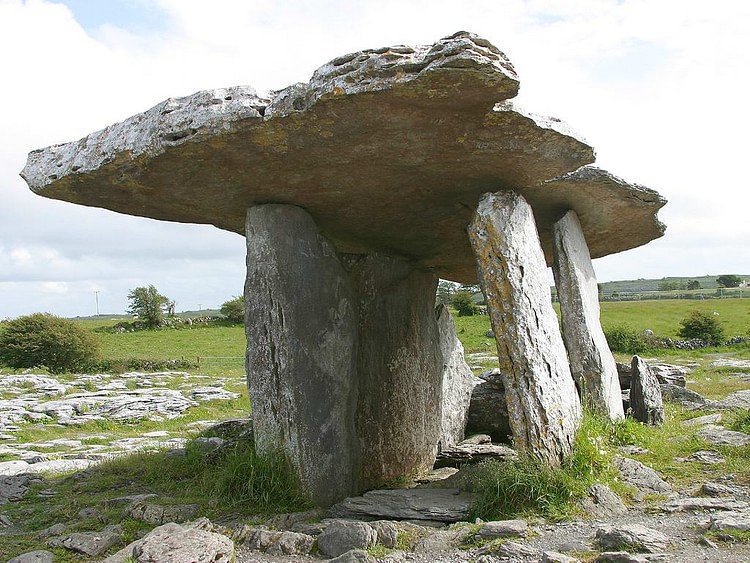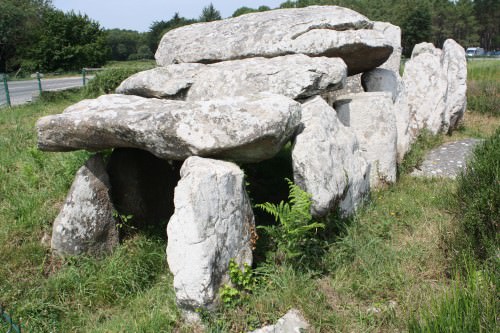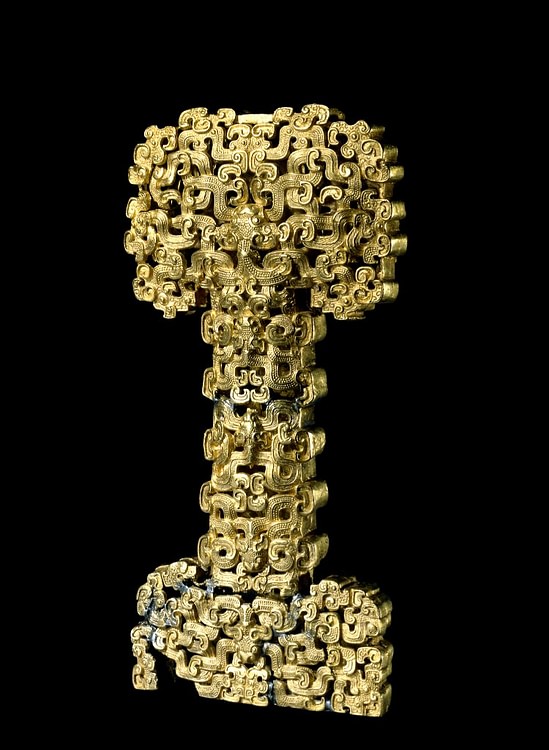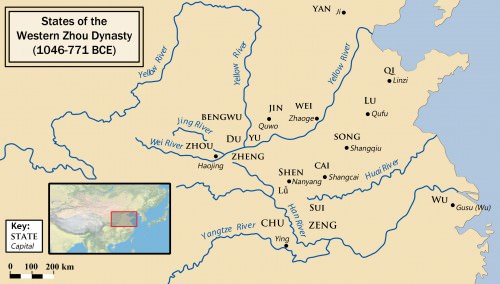Dolmen › Zhou Dynasty » Ancient origins
Articles and Definitions › Contents
- Dolmen › Ancient History
- Zhou Dynasty › Ancient History
Ancient civilizations › Historical and archaeological sites
Dolmen › Ancient History
Definition and Origins

A dolmen is a megalithic structure typically formed from a large horizontal stone slab resting on two or more upright slabs.The oldest European examples are found in Brittany, northern France, and date to the 5th millennium BCE. Dolmens are also present in the Middle East, North Africa, Asia, and especially large numbers exist in Korea, with examples there dating to c.1000 BCE. The structures functioned as burial chambers or as sites of ancient cult worship, for example to an earth or fertility goddess.
NAMING
Megalithic architecture, specifically the construction of sanctuaries and tombs using enormous blocks of stone, occupies an important position in the cultural experience of Prehistory. The word dolmen, which derives from Breton t(d)aol meaning table and men or min meaning stone, appears in the scientific debate around the end of the 1700s CE. Until that time the examination of these “strange” monuments, scattered here and there, gave way to suppositions that were, to say the least, fanciful. It was thought they were works built by giants or, indeed, deeds of the devil. The first investigations were, therefore, to understand the use of these structures and establish their age, even though the absence of metal objects indicated the period they could belong to.
PRELIMINARY INVESTIGATIONS
In the second half of the 1800s CE, the publication of the first European map of the known megalithic localities highlighted so many coincidences that it led to the belief that they were the work of one unique population. Therefore it seemed justifiable to consider the “megalithic phenomena” an unusual cultural manifestation of the Near East and dolmens, in definition, the unnatural reproduction of the Mediterranean burial grotto.

Kermario Dolmen, Carnac
The Australian archaeologist V. Gordon Childe reinforced this hypothesis in his last book The Prehistory of European Societywhere he claimed that the construction of the enormous mausoleums was carried out by mythical megalithic missionaries, members of some early Aegean tribes from the eastern Mediterranean, who divulged a religious faith known to belong to the cults of Gaia the Mother Goddess, goddess of the earth.
DATING
The perfection of absolute dating systems, thanks to the 14C radio-carbon method, put an end to this thesis once and for all. It was proven that the oldest megalithic tombs originated in central/northern Europe. Breton dolmens date back to 4500 BCE (earlier, therefore, than the Egyptian pyramids, Mesopotamian ziggurats and the great Cretan and Mycenae sites). They spread further south to central and southern France, south-west to Spain and Portugal and north-east to the central lowlands of Europe, Sweden and so on. They concluded their phase with the most recent constructions in Malta, around 2400 BE and in Italy at the beginning of the 2nd millennium BCE.
INESTIMABLE PROBLEMS HAD TO BE FACED SUCH AS FINDING SUITABLE STONES & THEN TRANSPORTING THEM.
The above time range was sufficient for each region to evolve a local typology though keeping a common characteristic: the use of blocks or slabs of stone, at times colossal in dimension, which made them phenomena tied to a fairly widespread culture.
The Mediterranean dolmens are to be dated back to an era closer to ours. Around 100 can be found throughout Sardinia, some of which, the so-called dolmen cysts made up of stone slabs assembled in a cubiform manner, are dated back to the Copper Age, around 3000-2100 BCE. Dolmens in southern Italy, which are more recent, date back to the first half of the 2nd millennium BCE, the period corresponding to the latter phase of the Bronze Age.

Dolmen, Gochang, Korea
Outside of Europe, the most frequent occurrence of dolmens is in the Korean peninsula where there are some 200,000 megalithic structures. Korean dolmens are remarkably similar to those found in Europe. Finds excavated from within many of the dolmens illustrate that they were typically used for elite burials. Unusually, Korean dolmens were sometimes built in close proximity to each other, creating cemetery-like areas consisting of between 30 and 100 structures.
PRINCIPAL CHARACTERISTICS
The most elementary configuration of the dolmen is trilithic: a horizontal slab of stone placed on top of two vertically positioned stones in order to form a construction where the structural elements frame a quadrangular space. Such forms can be found just about anywhere, in Iceland, Scotland, England, North Germany, France, Spain, Scandinavia, Denmark, Holland, Corsica, Sardinia, Apulia, Sicily, Malta, North Africa, Morocco, Tripoli, Egypt, Syria, Palestine, Bulgaria, Crimea, Caucasus, Iran, India, Korea.
More complex forms which were made up of a long or even longer succession of triliths followed, so generating two particular types: the corridor tomb and the gallery tomb ( allée couverte ). The corridor tombs, made of big slabs of stone vertically fixed into the ground (orthostats), have corridors that vary in length and lead to a chamber or a number of chambers of a polygonal shape. The gallery tombs, instead, have just one rectangular-shaped space used entirely as a sepulchral chamber.

Elementary Configuration of a Dolmen
Some of these structures evolved into rather complicated constructions, as in the case of the false dome dolmens where the convex roof was obtained by gradually decreasing the distance between the slabs of the building. Another instance is that of the dolmens with lateral chambers; characterised by a series of cells around the central one. Each sepulchre, or series of sepulchres, was completed by being covered with earth mixed with stones.
Inestimable problems had to be faced in whichever region they were built such as finding suitable stones and transporting the material for construction. In those areas where the stone was extremely hard and difficult to shatter, they raised enormous monuments; whereas, in other places where the stone was easy to chip, dry-stone method structures were built rather than using the real megalithic technique. This is the case of the small Sicilian dolmens.
To the south, the islands of Malta and Gozo are home to the most extraordinary prehistoric sites of the Mediterranean, the “megalithic temples”. They were built between about 4000 and 2500 BCE. They were dedicated to a cult worshipping a fertility goddess. The dolmens, as they should be correctly called, (around 20 in all) are to be dated back to a successive period (the second half of the 3rd millennium BCE). In most cases, we are dealing with small chambers, with the cover made of a large slab placed on upright stones. They are claimed to belong to a population certainly different from that which built the previous megalithic temples.

The Dolmen of Monte Bubbonia
Not all megalithic stone structures were funeral monuments: the cromlechs of Stonehenge in England and the Carnacmenhirs in France, to mention some, would have served other extraordinary purposes, perhaps connected to the practice of an astronomy cult. They could have represented the product of a culture that sought to capture the irradiation centre of absolute positive energy in the universe. The “prototype” of this architecture almost certainly had its origins in a series of lucky coincidental factors - the natural occurrence of fallen stones or some suggestive natural “scenery” must have let loose the religious imagination of certain prehistoric communities. So much so, an exceptional mystic significance was given to the stones.
Zhou Dynasty › Ancient History
Definition and Origins

The Zhou Dynasty (1046-256 BCE) was the longest-lasting of ancient China ’s dynasties. It followed the Shang Dynasty (c. 1600-1046 BCE) and it finished when the army of the state of Qin captured the city of Chengzhou in 256 BCE. The long history of the Zhou Dynasty is normally divided in two different periods: Western Zhou (1046-771 BCE) and Eastern Zhou (770-256 BCE), so-called following the move of the Zhou capital eastwards where it was safer from invasion.
The most influential minds in the Chinese intellectual tradition flourished under the Zhou, particularly towards the last period of the Zhou Dynasty, considered a time of intellectual and artistic awakening. Many of the ideas developed by figures like Laozi, Confucius, Mencius and Mozi, who all lived during the Eastern Zhou period, would shape the character of Chinese civilization up to the present day.
THE ORIGINS OF THE ZHOU DYNASTY
The Zhou people were not invaders; they were Chinese-speaking people descendant from the Longshan Neolithic culture.During the course of several centuries, the Zhou moved away from barbarian pressures, migrating towards the westernmost agricultural basin of North China, the lower Wei River valley, present-day Shaanxi province. Here they began to develop Shang-style agriculture, and they also built a city in an area named Plain of Zhou, which gave its name to the state and the dynasty. The Shang ruling class considered the Zhou “semibarbarious country cousins”. For many years the Zhou and the Shang coexisted alternating peace and war.
KING WEN (1152-1056 BCE) OF THE ZHOU IS DESCRIBED AS A LIVING STANDARD OF BENEVOLENCE & WISDOM.
The first important historical figure of the Zhou is King Wen (1152-1056 BCE), who is described as a living standard of benevolence and wisdom. He became king of Zhou in 1099 BCE during the last days of the Shang Dynasty. King Wen is credited with conceiving the ambitious plan of undermining the authority of the Shang by making alliances with neighbouring chiefs that gave the Zhou the military power to make conquest possible. Wen's growing power disturbed the Shang court to the point that they imprisoned him in the city of Youli. However, Wen's supporters ransomed him by giving the Shang a large number of gifts. The second son of King Wen was King Wu, who built a new capital and named it Haojing. In 1046 BCE, Wu led an army of 50,000 troops against a Shang army of 700,000 in a battle known as the Battle of Muye. The Shang people were so unhappy under the rule of the Shang king that the Shang soldiers offered little resistance and many of them joined King Wu's side. The Shang king retreated to his palace and committed suicide: He locked himself up in the building and set it on fire.
The Zhou justified the change of dynasty and their own authority by claiming that the dispossessed Shang had forfeited the " Mandate of Heaven " by their misrule. It was customary in ancient China to identify the supreme authority of rulers with a higher power. All subsequent dynasty changes in China would be justified with arguments along these same lines.

King Wen of Zhou
King Wu did not exterminate the Shang entirely: He left the Shang heir as nominal ruler of the city of Youli, but he assigned some of his own brothers to keep Youli under tight control. Wu returned to Haojing where he died still relatively young and his son, King Cheng, became the new Zhou ruler while he was still a child.
The Zhou were not able to fully control the eastern plain that the Shang had controlled, and King Wu did not elaborate a plan in order to accomplish such a goal. It was King Wu's brother, known as the Duke of Zhou, who performed the necessary steps for laying the basis upon which the Zhou Dynasty would consolidate its power throughout North China.
THE DUKE OF ZHOU CONDUCTED A NUMBER OF EXPEDITIONS EASTWARD TO BRING THE ENTIRE YELLOW RIVER PLAIN UNDER ZHOU CONTROL.
The Duke of Zhou was the chief and overseer of the newly conquered eastern plain and he was appointed as regent over the young King Cheng, who was his own nephew. The counterpart of the Duke of Zhou was his own brother, the Duke of Shao, chief overseer of the Zhou homeland in Shaanxi. As soon as the Duke of Zhou assumed his role as regent over King Cheng, his brothers in the city of Youli joined the Shang heir in a rebellion to take over power and restore the old Shang order: It seems that there was a widespread fear that the Duke of Zhou would usurp the throne form his young nephew. The Duke of Zhou reacted quickly by organizing his military strength and crushing the rebellion. He then conducted a number of expeditions eastward to bring the entire Yellow River plain under Zhou control. During this process he destroyed many small states and created new administrative units in their place. He also built a new capital in modern Luoyang, in the central Yellow River plains (modern Henan province) to serve as an auxiliary Zhou capital to administer the eastern territories. After accomplishing all of this in a timeframe of seven years, the powers that the Duke of Zhou had were extraordinary. This was not an obstacle for him to willingly give up his powers after he persistently lectured his nephew on the duties of a responsible ruler: King Cheng finally assumed his role and he ruled effectively until 1021 BCE.
WESTERN ZHOU (1046-771 BCE)
The Zhou Dynasty was never a wholly unified realm. The Zhou court extended its power over the eastern plain by granting authority to members of the royal family and in some cases to favoured adherents, who established walled forts supported by garrison troops among the original habitants of the east. In some cases, local chiefs were accepted as Zhou supporters.Hence, there came into existence a network of city-states on the plain, from which military and political control spread over the surrounding farming villages. Any local leader who challenged the Zhou order was quickly punished by the army and the regional delegates were closely watched.

Map of Western Zhou
There are many resemblances between the Zhou system and some of the forms of feudalism in medieval Europe, which is why the Zhou age is sometimes referred to as a feudal age. Even though the Zhou system was indeed feudal, it had many differences from medieval Europe. The most important difference was that the rulling class was mainly unified by kinship ties.Family relations were arranged by marriage where no kinship links existed. In this way, the local lords were expected to accept the authority of the king as the head of a large family. For three centuries after the Zhou conquered the Shang, Zhou rulers maintained order in North China and expanded their territories.
As time went on, the kinship ties loosened and the local rulers became less identified with the Zhou king and more with their allocated territories. This tendency was very strong in larger peripheral states. By the 9th century BCE, regional leaders started to ignore their duties to the Zhou court and also fought among themselves. The declining order in the realm encouraged non-Chinese on all sides to penetrate the borders. King Li (r. 877-841 BCE) led 14 armies against non-Chinese forces to the south and southeast with no positive results.
Finally, King Xuan (r. 827-782 BCE) fought many defensive wars against non-Chinese in the north during most of his reign. In 771 BCE, his son, King You, was killed during a barbarian invasion in Haojing, the capital city, which was overrun and sacked by a group of northeners. The royal heir and some of the court members who managed to survive the disaster decided that Haojing was too vulnerable to assaults from the frontier, so they abandoned the city and the eastern auxiliary capital at Luoyang became the new royal capital. This was the major turning point in the Zhou Dynasty, which marks the end of the Western Zhou period.
BATTLES BETWEEN REGIONAL LEADERS WERE RELATIVELY SHORT &, FOR THE NOBLES, RESTRAINED BY A CODE OF CHIVALRY.
During the Western Zhou period, goods circulated mostly through tribute and gift rather than trade, cities were noble fortresses, artisans were a hereditary caste of serfs attached to states or courts, and ministers and court members were chosen based on birth rather than talent. Battles between regional leaders were relatively short and, for the nobles, restrained by a code of chivalry.
EASTERN ZHOU (770-256 BCE)
After the barbarian invasion drove the Zhou rulers eastwards, the state of Qin became responsible for guarding the western frontier and they gradually moved eastward and eventually occupied the original Zhou domains. Thus the Qin became a close ally to the Zhou and they also had marriage relations with the Zhou ruling class. The city states slowly emerged as powerful independent fiefs and the real Zhou power disintegrated. The states located on the peripheries grew into major territorial powers, and its rulers normally had greater military and economic strength than the king, who was now dependent on a small royal domain around Luoyang. By 700 BCE, the state of Qin in the west, Jin in the north, Qi in the east and Chu in the south were the main centres of power in China. The royal Zhou domain on the central Yellow River plain was powerless in comparison to the peripheric realms.
The period from 772 to 476 BCE is known in Chinese history as the Spring and Autumn Period, so called after the name of the preserved official chronicle of the small state of Lu, in which the events throughout China between these dates are recorded.During this period, the military conflict gradually escalated. War after war, the different states started to annex each other and form the roughly 100 states that were in China in about 770 BCE - there were just 40 towards the end of the Spring and Autumn Period. This was a time of violence and social conflict: battles, civil wars, assassinations of rulers, and intrigues among aristocratic families. Battles slowly shifted from being relatively short and restrained by a code of chivalry to large-scale slaughters.
As a result of this growing conflict, rulers could no longer afford to hire their ministers on the basis of birth as talent become far more important. Trade expanded, money and goods circulated mostly through commerce, and rich merchants sometimes won high office. Thinkers competed for the ruler's patronage, moving from one court to the other explaining their social, economic, military and political views in search for employment. The main intellectual focus was practical political and social concerns while metaphysical speculations remained secondary. Arts and philosophy flourished in China like never before: Thinkers belonging to the diverse Hundred Schools of thought developed many different ideological traditions. This is the time when some of the most important Chinese schools of thought such as Daoism, Confucianism and Legalism were born.

Western Zhou Ritual Vessel
This situation led to the Warring States Period (476-221 BCE), where seven states were the chief contenders that fought for the control and unification of China. For many centuries China lived immersed in a situation of war, a disorder in which none of the competing states was strong enough to conquer all of the others, but many of them were strong enough to break that order.
THE FALL OF THE ZHOU DYNASTY
The Zhou Dynasty came to an end during the Warring States period in 256 BCE, when the army of the state of Qin captured the city of Chengzhou and the last Zhou ruler, King Nan, was killed. The real power of Zhou was so small, that the end of the dynasty was hardly noted. The Zhou state was thus absorbed by the state of Qin. The supremacy of the states of Qin, Qi and Chu was so great that it seemed for a time that China would be divided in three, one section for each state. However, chaos and war prevailed and the battles continued until eventually the state of Qin conquered the other states and unified China once more in 221 BCE, the beginning of the Qin Dynasty (221-206 BCE).
LICENSE:
Article based on information obtained from these sources:with permission from the Website Ancient History Encyclopedia
Content is available under License Creative Commons: Attribution-NonCommercial-ShareAlike 3.0 Unported. CC-BY-NC-SA License